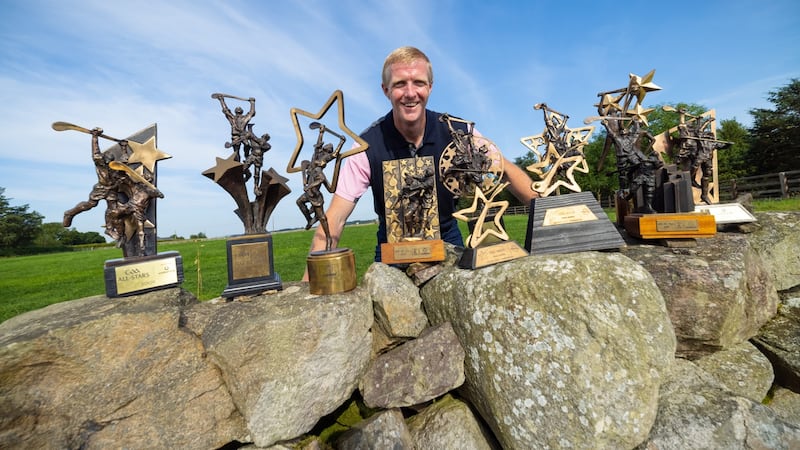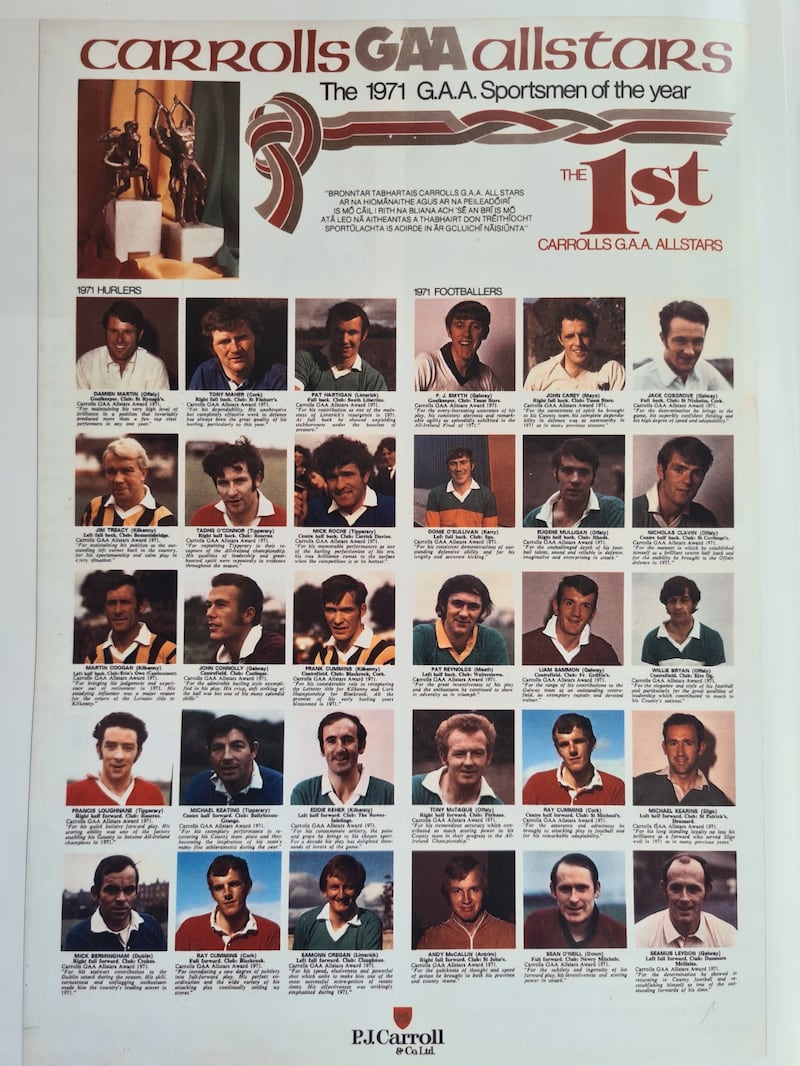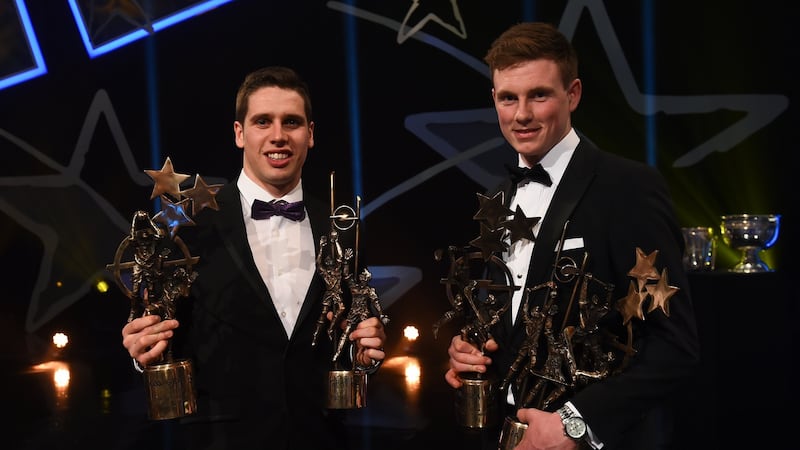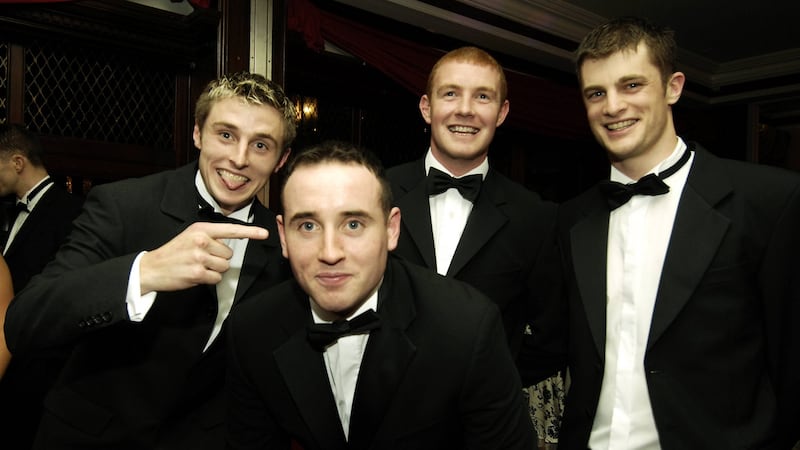They started and finished with GAA royalty, sitting down with Jimmy Barry Murphy in Cork city in June of 2018 and having an outdoor coffee with Jack O'Shea in Herbert Park shortly after the pandemic laid siege.
In between, Eileen and Moira Dunne clocked up countless miles meeting 136 of the some 800 hurlers and footballers who had received All Star awards over the half century since the ceremony was first dreamed up.
Their project became a book that is partly a labour of love and partly a tribute to the founding fathers of the scheme. Their father, the RTÉ Gaelic Games correspondent Mick Dunne, along with Padraig Puirseal of the Irish Press, Paddy Downey of the Irish Times and John D Hickey of the Irish Independent concocted the idea on a wet afternoon in Belfield.
The quartet travelled around the country as the only dedicated GAA journalists working in the Irish media landscape of the time. They were treated like lords. Sometimes, the Dunne girls would accompany their father on interviews and it was only later that they understood how much of a fuss they made - and was made of them.
The awards - always ornate and imaginatively sculpted mementoes - were highly valued in themselves
“Maybe it was something I took for granted,” says Eileen. “But even now as we were going around this time people would say I remember you in the house. The apple tart and scones were made. But I have to say the same thing applies this time. We got a great welcome wherever we went.”
If Michael O’Hehir is often anointed as the official broadcasting voice of the GAA, there is an argument to be made that Mick Dunne’s was the most unique - and maybe flowed deeper into the national subconscious with its peculiar, formal musicality.
Infact Mick Dunne’s voice, clear as spring water, seems perfectly suited to the role through which Eileen herself would later become a household name and voice: reading the flagship news programmes on RTÉ television. But she says that her father would never have wished to move away from his chief passion of covering Irish sport.

“I would have always made the distinction that for him, the GAA was the thing and the Irish Press and RTÉ were the vehicles. Whereas for me, I would say I am a broadcaster first.”
All Star Gazing is an unusual and unexpected book. Mick Dunne’s life in journalism began in the library of the Irish Press group. That experience enhanced his already meticulous record-keeping skills. A few years ago, Moira came across a box on the low shelf of his office at home. It contained highly detailed records, organised by calendar year, of the All Star scheme.
They wondered what to do with it and a friend of Moira’s casually suggested they had the beginnings of a book project. There was something intriguing to them about the idea. The GAA had played a huge role in their childhood. Family weekend outings revolved around Mick’s travels across the country, particularly during the summer championship.
The GAA were keen and the sisters set about arranging interviews with the players. They set out with a methodology of which their father would have approved, seeking out the first All Star team from 1971 and working forward from there. But it was only as they gathered the various conversations and memories that the true point of the All Stars became apparent.
The awards - always ornate and imaginatively sculpted mementoes - were highly valued in themselves. But the scheme acted as a mirror for the GAA and the country itself evolved over the decades. So the reminisces of the All Stars are about where they were in their lives at that moment as much as the games of any given season.

“Even for themselves, they would say at the start I can hardly remember,” Eileen says. “But then they would think about it and come and meet us and often remembered things they hadn’t spoken about for years.”
What materialised, over the course of almost two years of interviews, was a specifically Irish night of formal glamour whose changes reflected the radical shift in society over the subsequent five decades. The instantaneous success of the All Stars scheme must have surprised its backers. From the beginning, the players regarded the awards with solemn respect. The decision to go bold and posh from the outset was inspired. The 1971 All Star night was the first black-tie event in the history of the association.
Two hundred cigarettes
A group of traditional musicians, after arriving at the inaugural banquet to entertain, were reluctant to enter the ballroom until they were convinced that the gathering was filled with ordinary people. One of the All Star recipients brought his fiancée to the ceremony: as they were unmarried, separate bedrooms were reserved for the couple. On top of each bed was 200 cigarettes: Carrolls were the sponsors of the original scheme. It was a different world.
The attendance of Jack Lynch, the Taoiseach in 1971 and a revered figure in Gaelic games, gave the event the imprimatur it needed. Lynch's letter of acceptance was found among Mick Dunne's files and is reproduced in the book. (Coincidentally, Lynch resigned as Taoiseach two days before the 1979 All Star banquet. The organisers were uncertain as to whether he would attend. He walked into a standing ovation. "At my last official function, I am back with my own - the GAA", he said).
They borrowed the uniforms of hotel staff to patch together something resembling black tie
Immediately, the first All Stars realised something that future teams would remark upon for the next 50 years: it was the one night of the year when they got to meet their biggest rivals and get to know them as something other than opponents.
The advent of the All Star trip was fabulously exotic in the early 1970s, even if the players ended up staying with host families in San Francisco rather than in hotels. The arrival of a plane full of bona fide Irish gladiators caused a fuss in the Irish-American enclaves of the city at that time.
Babs Keating ended up staying near a convent because his mother insisted he was close to a church for morning mass. Pat Spillane claimed the tourists spent half their time engaged in the busy game of avoiding Irish-American parents intent on landing a true Gael for their daughters. Spillane's observations are good fun throughout a book which covers the strengthening tour tradition in the 1980s and 1990s.
Some of the stories are gloriously daft. Galway's Pete Finnerty, living in New York when he won an All Star in 1987, was presented with his trophy in the sacristy of St Patrick's Cathedral. The trophy was then flown home to be presented to Finnerty's father at the official ceremony.
The Meath team, on holiday when the awards were held in 1988, were flown home on charter flights and managed to miss the connection from London. Colm O’Rourke phoned to say they wouldn’t make the event. Further planes were hastily procured and a Garda escort got the footballers to the hotel on time, when they realised they had no formal wear. They borrowed the uniforms of hotel staff to patch together something resembling black tie.

The publication of the book coincides with a period when the All Star idea has reached a bit of a crossroads. In the beginning, the novelty of elite Gaelic games drew big crowds to games in the USA and, in the 1990s, Canada. But in more recent years, arranging a serious, competitive game was impossible. The score lines became absurd and the visiting crowd non-existent.
Squeezed
The All Star trip became squeezed by the demands of the GAA schedule. All Star winners invariably belong to those counties competing in All-Ireland finals: often, the All Star trip conflicted with official team holidays. Fifty years in, it remains unclear as to whether the overseas trip has still run its course. Eileen Dunne feels that the prevailing belief is that the tour should be reimagined if it is to continue.
Some people think it is gone. But it is like the Railway Cup
“Some of the players said they enjoyed giving coaching sessions to local youngsters on the tours. But the matches had become a bit of a joke. So a decision has to be made. I think it depends. There is willingness there among the players to keep the tour going. But the GAA and All Stars would have to make a real effort to find a slot for it that wouldn’t impinge on other things.
"The Middle East and Far East is where the focus is now rather than the United States. And the other thing is that the focus of the tour has changed. It became more of a reward for the players - and for wives and partners as well. Which is not the way it started out.
“So decisions have to be made about it. Some people think it is gone. But it is like the Railway Cup. The players wanted it to continue for years even though nobody was turning up. And the players notionally still want this to continue.”

The All Star scheme itself remains in good stead. It’s clear from the interviews with more recent recipients that receiving an All Star is regarded as a milestone achievement, even for those who went on to be garlanded with record awards.
The Dunne sisters were forced to conduct the last few interviews on zoom and their plans for a party to match the wilder excesses of the All Star nights were reluctantly scotched because of pandemic protocols.
This year’s All Star awards night was also a reduced, virtual event. But the return of black tie nights and flashbulbs and unfettered glamour will be a sign that the country has returned to some kind of normality.












